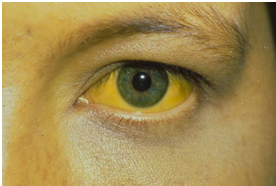Jaundice Causes, Symptoms, Diagnosis and Treatment

What is Jaundice?
Jaundice is a yellow discoloration of the skin, mucous membranes and the whites of the eyes caused by increased amounts of bilirubin in the blood. Jaundice is a sign of an underlying disease process.
Causes of Jaundice
Jaundice occurs most often as a result of an underlying disease that either causes tissue to be over-saturated with bilirubin or prevents the liver from disposing of bilirubin.
Some basic diseases that can cause Jaundice are:
- Acute inflammation of the liver – may affect the ability of the liver to conjugate and secretiate bilirubin, resulting in an accumulation of bilirubin.
- Inflammation of the bile duct – can cause secretion of bile and removal of bilirubin, causing gel failure.
- Obstruction of the bile duct – prevents the liver from the disposal of bilirubin, which leads to hyperbilirubinaemia.
- Hemolytic Anemia – The production of bilirubin increases when large amounts of erythrocytes are broken down.
- Gilbert’s syndrome – an inherited condition that affects the ability of enzymes (biomolecules that cause chemical reactions between substances) to process the excretion of bile.
- Cholestasis – a condition in which the bile flow from the liver is interrupted. The bile, which contains conjugated bilirubin, remains in the liver instead of excreted.
More rare conditions that can cause Jaundice are:
- Crigler-Najjar syndrome – an inherited condition that affects the enzyme responsible for the processing of bilirubin, resulting in an excess of bilirubin.
- Dubin-Johnson syndrome – an inherited form of chronic gelatin that prevents conjugated bilirubin from excreting the liver cells.
- Pseudojundice – a harmless form of gelling, in which the yellowing of the skin is due to a surplus of beta-carotene, not to an excess of bilirubin; Usually from eating lots of carrots, pumpkin or melon.
Symptoms of Jaundice
The symptoms of Jaundice include:
- nausea and vomiting,
- abdominal pain,
- fever,
- weakness,
- loss of appetite,
- headache,
- confusion,
- swelling of the legs and abdomen, and
- newborn jaundice
In newborns, as the bilirubin level rises, jaundice will typically progress from the head to the trunk, and then to the hands and feet. Additional symptoms that may be seen in the newborn include:
- poor feeding,
- lethargy,
- changes in muscle tone,
- high-pitched crying, and
- seizures
Diagnosis of Jaundice
The following tests and imaging studies may be obtained:
Blood test
- Cbc count
- Liver function test
Urinalysis
Imaging studies
- Ultrasound
- Computerized Tomography (C.T. scans)
- Magnetic Resonance Imaging (M.R.I)
- Endoscopic retrograde cholangiopancreatography (E.R.C.P)
Liver Biopsy
Treatment of Jaundice
Treatment depends on the cause of the underlying condition leading to jaundice and any potential complications related to it. Once a diagnosis is made, treatment can then be directed to address that particular condition, and it may or may not require hospitalization.
- Treatment may consist of expectant management (watchful waiting) at home with rest.
- Medical treatment with intravenous fluids, medications, antibiotics, or blood transfusions may be required.
- If a drug/toxin is the cause, these must be discontinued.
- In certain cases of newborn jaundice, exposing the baby to special colored lights (phototherapy) or exchange blood transfusions may be required to decrease elevated bilirubin levels.
- Surgical treatment may be required.
By : Natural Health News




